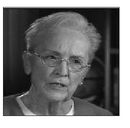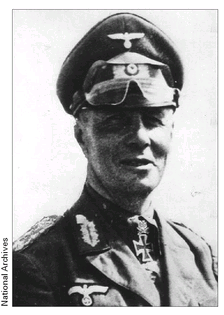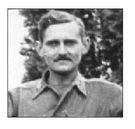War Stories III (13 page)
Authors: Oliver L. North

During peacetime, the U.S. military had been all male. The onset of war brought hundreds of thousands of American women into the Armed
Forces. No woman could be subject to conscription, but they didn't have to be: they volunteered so fast that many had to be told to return weeks or months later, after uniforms were made and facilities to house and train them were built. One of those young American women who volunteered early was nineteen-year-old Pearlie McKeogh from Minneapolis, Minnesota. After Pearl Harbor, she and her boyfriend decided to enlist together.
Forces. No woman could be subject to conscription, but they didn't have to be: they volunteered so fast that many had to be told to return weeks or months later, after uniforms were made and facilities to house and train them were built. One of those young American women who volunteered early was nineteen-year-old Pearlie McKeogh from Minneapolis, Minnesota. After Pearl Harbor, she and her boyfriend decided to enlist together.
PEARL MCKEOGH, WAAC
St. Paul, Minnesota
13 November 1942
13 November 1942

When Japan attacked the U.S. at Pearl Harbor, I was in business college but planned to join the Navy. Then I found the Navy wouldn't let women serve overseas, so I switched to the Army. I wanted to do something differentâget awayâI had never been out of Minnesota. My boyfriend at the time said, “Let's both sign up.” So we did. But he was rejectedâI was accepted.
My oldest brother went into the Coast Guard. One brother was a farmer in North Dakota and didn't enlist. Another brother worked for a manufacturing plant in Milwaukee and my fourth brother was a minister. Both my sisters were teachers.
Within a few days of being accepted as a WAACâWomen's Army Auxiliary CorpsâI was sent to Fort Snelling, near Saint Paul, for basic training. From there I was sent to a camp outside of Des Moines, Iowa.
In the camp at Des Moines they took the roster and they divided it in three. To one of the groups they said, “You're cooks and bakers.” To another they said, “You're secretarial.” And to the third group they said, “You're drivers.” I ended up in the office because I had just finished business college, but they quickly figured out that I didn't know anything about typing.
So they put me in the motor pool, where I wanted to beâdriving a jeep and a two and a half ton truck. We had girls out on that range
that had never driven before, but the Army taught them how to be good drivers.
that had never driven before, but the Army taught them how to be good drivers.
After learning how to drive and maintain jeeps and trucks, we went to Florida for more training and then in late December of '42 we were ordered to Brooklyn, New York, to await shipment overseas.
In early January '43, I was one of 196 WAACs loaded on a troopship for deployment overseas. We had our own compartment on one deck, and there were soldiers above and below us.
We had no idea where we were going and the weather was terrible. We ended up in Algiers, in the middle of the night, in the middle of a German air raid. We loaded up on trucksâI was in a truckload of women. Because of the blackout, the driver of our truck got lost, so we were the last ones to arrive at our billet. We were billeted in a home operated by the Daughters of Charity. It was roughâthere was no running water, no amenities.
A couple of days later, I was told to report to the 1st Army Headquarters to see if General Eisenhower wanted a woman driver. Not many generals did, but General Eisenhower said to Colonel Lee, the Headquarters Commandant, “I'll take one, and if she works out, the rest them can also work in the motor pool.” So I was picked as the test case and it evidently worked out, because the rest of the women went to work in the motor pool.
When I got to Algiers, I didn't know what a general was. The highest rank I had seen up to that point in the Army was a colonel, back at Des Moines. He was in charge of the training center. But, the first day that I went to work Colonel Lee in Algiers he said, “Pearlie, take the general to the airport.” I didn't know where the airport was but I said, “Yes, sir!”
One of the other drivers, who knew where the airport was, jumped in the jeep with me. That was my first day on the job as General Eisenhower's driver.
What Private Pearlie McKeogh didn't knowâbut would soon find outâwas the general she was assigned to drive was fast becoming one of
the most successful officers in the U.S. Army. Dwight D. Eisenhower had been a colonel, serving in the Philippines on the staff of General Douglas MacArthur. He was just completing four years with MacArthur when Hitler started his blitzkrieg across Europe.
the most successful officers in the U.S. Army. Dwight D. Eisenhower had been a colonel, serving in the Philippines on the staff of General Douglas MacArthur. He was just completing four years with MacArthur when Hitler started his blitzkrieg across Europe.
After eight years of desk duty, Eisenhower was glad to return to the U.S. in January 1940 to help organize the training for a slowly growing U.S. Army. Eisenhower established himself as a master logistician and planner during the Louisiana exercises in 1940. By the time the Japanese bombed Pearl Harbor, he was a general, one of General Marshall's most trusted and highly regarded subordinates.
At the Arcadia Conference in Washington in December 1941, Churchill had pressed Roosevelt for an operation in North Africa. Marshall resisted the ideaâurging instead that the Allies gather necessary troops and materiel in England for a cross-channel invasion of France. By April 1942, when the U.S. and British military chiefs met in London for further strategic talks, it was increasingly clear that a “Second Front” in Europe in 1942 or '43 was simply too risky.
Months later, from 18â27 June 1942, Churchill again visited Washington. This time his arguments for attacking Hitler's forces in North Africa as a second front persuaded Roosevelt. The decision made, Marshall set a dateâthe first week of November 1942âand appointed Eisenhower to command the first U.S. offensive in the European theater: Operation Torch.
CHAPTER 5
AMERICA GOES ON THE OFFENSIVE 1942
E
very Allied military planner hoped that Operation Torch could be carried off without pitting a green, untested U.S. Army against the Wehrmacht. Accordingly, the landing beaches selected for the operation were well to the west of the combat-hardened German and Italian troops of the Afrika Korpsâled by one of Hitler's ablest generals, Erwin Rommel, nicknamed the “Desert Fox.” Nothing, however, could change the fact that the operation would take place in some of the most inhospitable and difficult terrain on the planetâthe largely barren, trackless North African desert.
very Allied military planner hoped that Operation Torch could be carried off without pitting a green, untested U.S. Army against the Wehrmacht. Accordingly, the landing beaches selected for the operation were well to the west of the combat-hardened German and Italian troops of the Afrika Korpsâled by one of Hitler's ablest generals, Erwin Rommel, nicknamed the “Desert Fox.” Nothing, however, could change the fact that the operation would take place in some of the most inhospitable and difficult terrain on the planetâthe largely barren, trackless North African desert.
Senior U.S. officers in London and Washington pointed out that raw American soldiersâsome just weeks out of recruit trainingâand their inexperienced leaders were unprepared to go up against the Vichy French in North Africa, much less the Axis powers. Some feared that if the operation went badly, it could well lead to postponing or even canceling plans to force a landing on the European continent until 1945 or '46.
George Marshall, the U.S. Army chief of staffâand one of Roosevelt's most trusted advisorsâwas utterly opposed to the North African endeavor, arguing that it would sap personnel and equipment needed for invading
the continent. The operation's strongest proponentâWinston Churchillâremained adamant that a “Second Front” had to be opened in Europe to help relieve pressure on Stalin and the Red Army, and he strongly believed that North Africa was the place. Roosevelt resolved the matter after Churchill's visit to Washington at the end of June 1942.
the continent. The operation's strongest proponentâWinston Churchillâremained adamant that a “Second Front” had to be opened in Europe to help relieve pressure on Stalin and the Red Army, and he strongly believed that North Africa was the place. Roosevelt resolved the matter after Churchill's visit to Washington at the end of June 1942.
FDR informed Marshall of his decision to proceed with Torch on 25 July. The next day, Marshall appointed General Dwight Eisenhower as the Allied commander in chief of the American-British expedition. Though he had never led so much as a platoon in combat, Eisenhower was now going to command an entire army.
Â
Rommel, the Desert Fox

For the next three months, Eisenhower and his staff engaged in a furious round of planning. The goals of Torchâalthough ambitiousâwere relatively simple: first, to deny the use of air and naval bases in northwest Africa to the Axis, and thenâby driving the enemy out of Mediterranean North Africaâcreate secure sea-lines between Gibraltar and the Suez Canal. If all went as planned, Rommel's German-Italian army would be caught in a pincers between General Bernard Montgomery's British 8th Army on the east and the forces landed in Torch moving in from the west.
To achieve these ends, Eisenhower assembled a fleet of more than 100 troop and cargo vessels, 200 U.S. and British warships, 500 aircraft, and 107,000 troops to force an entry in North Africa. Though Tunis was his ultimate goal, Eisenhower deemed that it was too far from his Gibraltar-based air coverâand too close to enemy air bases in Sicily, Sardinia, and Italy. He therefore selected three landing beaches well to the west, all in Vichy French territory.
A Western Task Force, commanded by General George Patton, would sail directly from the United States and seize Casablanca, Morocco. The Center Task Forceâcomprised of the U.S. II Corpsâwould sail from England to seize Oran, Algeria. And the Eastern Task Force of British and Americansâalso deployed from Englandâwould capture the Algerian capital.
Eisenhower hoped that the French colonial forces holding these port cities would quickly renounce fealty to the Vichy regime and aid the Allies in throwing the Nazis out of Africa. Weeks before the invasion, he commenced a series of sensitive, covert negotiations with French colonial officialsâmilitary and civilianâtrying to ensure that the Vichy troops in North Africa would not contest the landings. On 21 October Eisenhower dispatched Brigadier General Mark Clark by submarine to Algeria for an abortive clandestine meeting with French officers thought to be opposed to the Vichy regime.
It was all for naught. By 5 November, when Eisenhower boarded a Flying Fortress in London for a secret flight to his forward command post inside “The Rock” at Gibraltar, he and his commanders expected to have to fight their way ashore against as many as fourteen French divisions. Duplicity, intrigue, anti-British resentment going back to Dunkirk, personal rivalries and antipathy toward Charles de Gaulle among French officersâall doomed Allied hopes for a “gentle welcome” to North Africa.
Yet, as the convoys closed in on their landing beaches on the night of 7 November 1942, there was still reason for optimism. The hundreds of ships steaming from England, Scotland, Ireland, and the United States had made their transits without being attacked by enemy aircraft or submarines. Scores of bombers and fighters assembled at Gibraltarâthe only Allied airbase within range of the Torch landingsâwere unscathed and ready. And in the east, Montgomery's 8th Army had broken the long siege at El Alamein, Egypt. On 23 October his combined British, New Zealand, Australian, South African, Indian, Free Polish, Free Czech, and Free French force had smashed through Rommel's lines and was now driving the battered Afrika Korps and their Italian comrades westward toward the Libyan border.
Few of the young Americans preparing to land before dawn on a hostile shore were aware of these details. Some of them knew that FDR would broadcast an appeal to the French just before the landings: “The sons of those who helped liberate your fathers from the Germans in 1918 are coming to free you from Hitler . . . do not fire upon them.”
But for most, like Lieutenant Robert Green, in the 1st Infantry Division, the hours before the assault were consumed with final preparatory details, a letter homeâto be left on the ship, just in caseâand perhaps a prayer for what was to come in the morning, just before dawn.
FIRST LIEUTENANT ROBERT GREEN
1st Infantry Division
Arzu, French North Africa
12 November 1942
Arzu, French North Africa
12 November 1942

I was in ROTC at Penn State when the war started. I took my commission as an infantry officer and was shipped to England to join the Big Red Oneâshortly after finishing infantry officers' basic training at Fort Benning. In August 1942 they assembled us at Glasgow, in Scotland. There, we got onboard the ships, practiced doing amphibious landings, and then we sailed for the Canary Islands. We were there for a few weeks, and then suddenly we turned and went in through Gibraltar on the night of 5â6 November as part of an enormous fleet of blacked-out ships. The weather was terribleâbut even so, everyone was worried about air attacks from Sicily.
The night of 7 November we all wrote letters to our family and left them on the ship to be mailed. We landed the following morning, before dawn, west of Oran, in Algeriaâas part of the Center Task Force. Amphibious landings always appear chaotic. Though it was dark, my rifle platoon landed where we were supposed to, on the proper beaches.
The plan was to let the French know that we were Americans. Shortly after we landed, the French sent up a flare and called out in French to our troops over a bullhorn. Then they opened fire at us and we had a number
of casualties. Our response was a few mortar shells sent their way on the beach and they shut that up real quick.
of casualties. Our response was a few mortar shells sent their way on the beach and they shut that up real quick.
After landing we were ordered to bypass Arzu, which we finally did. We were to envelop Oran from the rear, which the enemy wasn't expecting. The French garrison at Oran was still proclaiming loyalty to the puppet Vichy governmentâand therefore they were collaborating with the Nazis.
They had a big naval installation at Oran and there were a lot of ships in the port. Naval guns protected the place, and we encountered them later. We moved down the road towards Oran, and I had established a command post for the regiment, not far off the beach.
As we were setting up the CP and the men were digging in, an American, who was a member of the French Foreign Legion, was escorted up to the command post. He had turned himself in, so he wasn't considered a prisoner of warâbut he was wandering around the area and he said to me, “Your men are very brave. The bullets come in here and your men have nothing to stop them.”
My men had started to dig in behind a hedge of cactus, so I said, “They're not as brave as you think. They think that they're behind a stone wallâwhen they find out differentlyâthey'll dig quicker.” And they did.
The French naval personnel in the port opened up on us as we moved toward the city. The troops that were firing at us weren't Germansâthey were French. I was very nearly killed there by a Frenchman firing a machine gun. Fortunately our mortar platoon opened up on him and when the mortar rounds got close, he took off.
It took us three days to get into Oran. Throughout the whole time we were taking heavy shellfire from some of the big naval guns on the ships in the port. On the third day, while we were trying to move forward, I noticed a bunch of signal flags being hoisted up a pole on top of a building to our front. It suddenly dawned on me that their forward observers were using the signal flags to adjust the naval gunfire.
My driver and I used the machine gun to shoot up the flagpoleâand we stopped taking fire. The French gave up easily after that but we had
already taken a lot of casualties from the people we had come to liberate. Later that day, instead of their ships joining the Allied cause, they scuttled their fleet.
already taken a lot of casualties from the people we had come to liberate. Later that day, instead of their ships joining the Allied cause, they scuttled their fleet.
Other books
Sasha's Dilemma by T. Smith
Candace Carrabus - Dreamhorse 01 - On the Buckle by Candace Carrabus
The Magic Catcher by Cassie Clarke
Souls ReAligned by Tricia Daniels
Murder Most Finicky by Liz Mugavero
The Tender Flame by Al Lacy
Rise (Roam Series, Book Three) by Stedronsky, Kimberly
Flygirl by Sherri L. Smith
The Book of Feasts & Seasons by John C. Wright
WolfsMate_JCS by Desconhecido(a)
